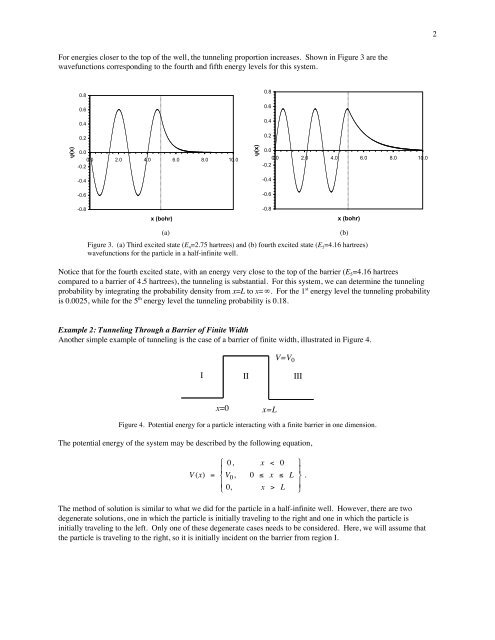Tunneling
Tunneling
Tunneling
Create successful ePaper yourself
Turn your PDF publications into a flip-book with our unique Google optimized e-Paper software.
2<br />
For energies closer to the top of the well, the tunneling proportion increases. Shown in Figure 3 are the<br />
wavefunctions corresponding to the fourth and fifth energy levels for this system.<br />
0.8<br />
0.8<br />
0.6<br />
0.6<br />
0.4<br />
0.4<br />
0.2<br />
0.2<br />
ψ(x)<br />
0.0<br />
0.0 2.0 4.0 6.0 8.0 10.0<br />
-0.2<br />
ψ(x)<br />
0.0<br />
0.0 2.0 4.0 6.0 8.0 10.0<br />
-0.2<br />
-0.4<br />
-0.4<br />
-0.6<br />
-0.6<br />
-0.8<br />
-0.8<br />
x (bohr)<br />
x (bohr)<br />
(a) (b)<br />
Figure 3. (a) Third excited state (E 4 =2.75 hartrees) and (b) fourth excited state (E 5 =4.16 hartrees)<br />
wavefunctions for the particle in a half-infinite well.<br />
Notice that for the fourth excited state, with an energy very close to the top of the barrier (E 5 =4.16 hartrees<br />
compared to a barrier of 4.5 hartrees), the tunneling is substantial. For this system, we can determine the tunneling<br />
probability by integrating the probability density from x=L to x= ∞. For the 1 st energy level the tunneling probability<br />
is 0.0025, while for the 5 th energy level the tunneling probability is 0.18.<br />
€<br />
Example 2: <strong>Tunneling</strong> Through a Barrier of Finite Width<br />
Another simple example of tunneling is the case of a barrier of finite width, illustrated in Figure 4.<br />
V=V 0<br />
I II III<br />
x=0 x=L<br />
Figure 4. Potential energy for a particle interacting with a finite barrier in one dimension.<br />
The potential energy of the system may be described by the following equation,<br />
V (x) =<br />
⎧⎧ 0,<br />
⎪⎪<br />
⎨⎨ V 0 ,<br />
⎪⎪<br />
⎩⎩ 0,<br />
x < 0<br />
0 ≤ x ≤ L<br />
x > L<br />
⎫⎫<br />
⎪⎪<br />
⎬⎬ .<br />
⎪⎪<br />
⎭⎭<br />
The method of solution is similar to what we did for the particle in a half-infinite well. However, there are two<br />
degenerate solutions, one in which the particle is initially traveling to the right and one in which the particle is<br />
€<br />
initially traveling to the left. Only one of these degenerate cases needs to be considered. Here, we will assume that<br />
the particle is traveling to the right, so it is initially incident on the barrier from region I.

















